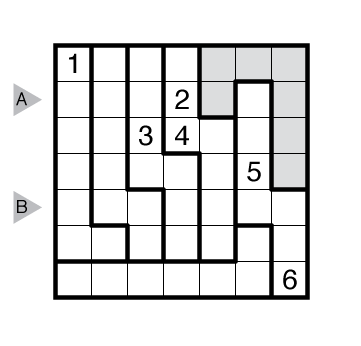Sudoku by Thomas Snyder

or solve online (using our beta test of Penpa-Edit tools)
Theme: Desperately Seeking Seven (Note: the shading of the “7” shaped region is just for artistic purposes.)
Author/Opus: This is the 173rd puzzle from Thomas Snyder, aka Dr. Sudoku.
Rules: Standard Sudoku rules (no repeats in any rows, columns, or bold regions). The digit range is 1-7.
Answer String: Enter the 2nd row from left to right, followed by a comma, followed by the 5th row from left to right.
Time Standards (highlight to view): Grandmaster = 1:15, Master = 2:00, Expert = 4:00
Solution: PDF
Note: Follow this link for other classic Sudoku. If you are new to this puzzle type, here are our easiest Sudoku to get started on. More classic Sudoku puzzles can be found in The Art of Sudoku, The Art of Sudoku 2 and in our beginner-friendly collection Intro to GMPuzzles by Serkan Yürekli.

Excellent puzzle, thank you!
I have never seen an N – 1 clue N times N Sudoku with N larger than 7. (I have seen one more with N = 7, by Bram: http://puzzlepicnic.com/puzzle?1624.) Have you seen any?
I’ve been wondering for some time now if such puzzles are possible for all N. Your construction hints rather strongly at the following example,
a b c d e f g h h
a b c d e f g g h
a b c d e f f g h
a b c d e e f g h
a b c d d e f g h
a b c c d e f g h
a b b c d e f g h
a a b c d e f g h
i i i i i i i i i
(N = 9, letters correspond to regions; it doesn’t matter much where the clues are placed as long as they are all different.) which puts my original question to rest but does not make for a particularly exciting solve.
http://www.bumblebeagle.org/dusumoh/proof/index.html
Great, thank you 🙂
Damn, I wish you’d posted
uggc://jjj.ohzoyrorntyr.bet/qhfhzbu/cebbs/vaqrk.ugzy
🙂
I knew i should not have looked at the comments before trying to solve it…
6:55
For being a Monday puzzle, there was one inference that eluded me for a very long time. It came up with eighteen squares left and only three digits left to use. Any tips on how I should have recognized the situation without bifurcating?
V guvax vg pbzrf qbja gb gur chmmyr trbzrgel. V unccrarq gb unir n uvtuyvtugre unaql, naq V uvtuyvtugrq gur ybjre yrsg fdhner. V qvqa’g xabj jung ahzore jbhyq tb gurer, ohg V fnj gung V pbhyq gura uvtuyvtug rireljurer ryfr va gur chmmyr jurer gung ahzore jbhyq raq hc. (Lbh pbhyq qb guvf fgrc rira jvgubhg nal bgure pyhrf, ohg gur bgure pyhrf jvyy gryy lbh jung gung ahzore unf gb or.) Gur erfg bs gur chmmyr sybjrq rnfvyl nsgre gung.
Thanks. I came at it from the wrong direction entirely (working right to left instead of left to right), which just got me tangled up in knots. Not sure if I’m bad at sudoku or I just need more practice — in any case I’m glad that WPF/LMI/etc have separate sudoku contests vs. puzzle contests…
I can relate – I am definitely bad at Sudoku! I am a little better at figuring out the geometry on these irregular puzzles, as well as some of the variations, but give me a classic 9×9 Sudoku grid and it takes me forever to finish the puzzle.
I understood when writing this that it would be possibly more of a teaching example than an easy Monday puzzle. For solvers that know the most basic use of Law of Leftovers in grids like this, many digits will come very fast. For others it can still be hard.
I recall one of the LMI Screen Tests tried the same trick and people were split on whether it was appropriate for an “in your head” question or not.
But more to your specific comment about the last 18 squares, I couldn’t replicate the stall point but presumably you have 1,5,7, and almost all of 6 finished? I don’t think there is anything beyond law of leftovers required anywhere but without seeing your exact grid it is hard to say what use of that rule is missing.